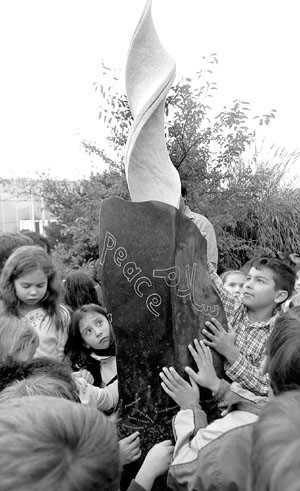
Children’s sculpture unveiled

David Yamamoto / The Daily
Children
of Jewish and Arabic backgrounds help unveil the “Middle East Peace
Sculpture” they helped create. “peace” is engraved in Arabic, Hebrew and
English on the sides of the basalt column (left), as are their names.
by Blythe Lawrence
10/24/2003
One year ago, Mona Atallah and Maia Brown didn’t know each other.
On the surface, they have little in common. Brown is Jewish, Atallah is Arabic.
Brown’s mother, Sandra Silberstein, is a UW English professor. Atallah’s
father works in the chemistry department, but the two had never met. An art
project designed to erase cultural barriers has brought them together and made
them friends.
Both are active within their communities. Brown frequents Kadima, the Jewish
Community Center in downtown Seattle. Atallah is active at the Arab Center of
Washington.
Children from the Arab Center of Washington, Kadima and the Iraqi Community
Center joined hands yesterday to unveil the “Middle East Peace Sculpture” in
the Peace Garden of Seattle Center. Seattle Mayor Greg Nickels then declared
Oct. 23 Children’s Peace Day, and issued a proclamation encouraging “all
citizens to join our children in their inspirational efforts to promote peace
and harmony in the world.”
Amineh Ayyad, UW alumna and chair of the Arab Center’s Education Committee,
conceived the Sculpting for Peace program. Ayaad, a Palestinian American, teamed
up with local Iraqi sculptor Sabah Al-Dhaher to create the piece and invited the
children, including her son, to participate in its creation.
The marble and clay sculpture took more than six months to create. The children
spent six Sunday afternoons in Al-Dhaher’s studio, sketching and sculpting
their ideas for creation in a 3-D medium. The goal was to create a work of art
that would promote peace, while representing each culture.
Brown and Atallah met when both served as counselors for a peace camp held for
children last year, and became friends almost instantly.
“We got to know each other at the peace camps, and it was an environment where
everyone was just .... together,” explained Atallah.
“It was a bonding experience,” Brown agreed. Commenting on their cultural
differences, she added, “I’m Jewish and she’s Arabic, and we’re friends,
but it really isn’t that big of a deal.”
At the ceremony, Brown and Atallah took turns reading stanzas of a poem written
by Christopher Knaus, a UC-Berkeley professor.
“In a time of broken treaties, we are here and we are hope,” they ended in
unison.
During the ceremony, about 40 children stood before a crowd of their elders,
reporters, city politicians and other adults.
“[It was] the only salvation we could hope for,” said Rep. Jim McDermott,
D-7th District, at the presentation, “that kids will understand better than
adults the spirit of humanity.”
Brown and Atallah are proud of the way the statue turned out. The names of all
the children who helped create the sculpture are engraved on the hardened clay
at the bottom of the piece.
“Our names are together on it,” said Brown.
At the end of the sculpture’s dedication, the children began to sing one of
the songs they had learned in a mixture of Arabic, Hebrew and English.
“I wish we could take all of you to Camp David for some peace talks,” said
City Councilman Peter Steinbrueck. “I hope that our political leaders in the
world who are making major decisions will look to your leadership and
example.”